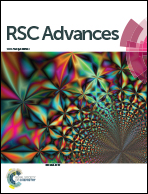BiOCl/SnS2 hollow spheres for the photocatalytic degradation of waste water†
Abstract
The doping effect of a new dopant to BiOCl as photocatalyst is studied. SnS2 as a narrow-band-gap semiconductor is used to tune the electronic and band structure of wide-band-gap BiOCl. BiOCl/SnS2 hollow spheres are synthesized by a facile and economic one-pot hydrothermal method. The shell of the hollow spheres is composed by BiOCl and SnS2, but the outermost layer is BiOCl. BiOCl/SnS2 hollow spheres exhibit much higher photocatalytic activity than pure SnS2 and BiOCl in the degradation of rhodamine-B under visible light and sun-light irradiation. The improvement is explained by the band structure tuning effect by SnS2 and the morphological benefits of the hollow sphere structure.


 Please wait while we load your content...
Please wait while we load your content...